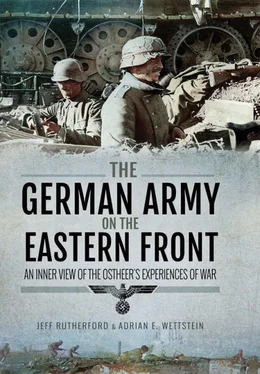a) total mobilization in Germany and Europe
b) total effort of the Russian population goal: quick end to the war
c) reference to the methods of the Soviet regime.
2) Evacuation for the protection of the population (especially children) from the rigours of war
a) entire settlements (village-wise)
b) no deportation to Germany, but rather temporary assignment to a new homeland
c) vacation, postal service for those left behind for a labour action
d) volunteers (advantages: food, clothing)
e) for the care of children, mothers or other suitable females
3) Closing Remarks (Vlasov)
4) Counter-intelligence – Espionage Danger
Three interesting points emerge from this document. First, the army was now explicitly demanding that the Soviet population, in concert with that of other European populations under German control, be mobilized in service of the German war effort. Second, forced evacuations had now become part and parcel of the daily activities of German units in the east, as civilians, their livestock and belongings were deported to the German rear in order for the Germans to exploit them for the war and simultaneously to deny their efforts to the advancing Red Army. Third, the mention of Andrei Vlasov, the Russian general who was captured in 1942 and then decided to collaborate with the Germans by heading the anti-Communist Russian Liberation Army, highlighted tangible efforts on the part of the army to yoke Soviet society to the service of the German war effort. [37]
The second document issued by the 126th Infantry Division in April 1943 was an attempt to convince its men about the necessity of Soviet manpower for the war effort and what this meant for the treatment of Soviet nationals. [38]The commander argued that
In order to ensure a successful execution of the labour service duty, a mental adjustment of the entire German occupation power towards the Russian people is necessary. Headquarters and agencies must know that those Russians conscripted for labour duty and volunteers cannot be treated as a mass of humanity who should be led to the slaughter, but rather as labour strength that the front, as well as the rear area services, urgently need and without the Russian people, the Russian farmer will never be able to survive. Under all circumstances, therefore, care must be taken so that those conscripted for labour duty and volunteers are treated and regarded as comrade-in-arms and that naturally, discipline must be maintained. It falls to us German officers and soldiers the task of making these people reliable allies of Germany, who are decisively interested in the outcome of this war and who are steeled against Bolshevik propaganda. While there are guidelines for the treatment of Hilfswillige , German agencies must be conscious that these Hilfswillige also have relatives and peasants and that likewise these relatives and peasants must be treated as humans from the side of the German occupation power, or then the action could lead to a danger for ourselves. From the German perspective, one must reckon that the enemy sees the Hilfswillige movement as great danger to himself and will try hard to sharpen our behaviour towards the Russian people. Disappointments from the ranks of the Hilfswillige are surely to be expected, but the unit commanders and German agencies should not be discouraged by them, and superiors should be especially not tempted to let the other Hilfswillige suffer. The responsible agencies and superiors must stress fairness, organizational strength, understanding and care. There is naturally always a place for strictness and discipline. Arrogance and brusqueness must, however, cease; likewise snide remarks in German. Russians should, if possible, eliminate their mistakes and also reprimand them themselves, punishments for specific actions should be announced ahead of time. One must always keep in mind that the Russian is a person, who will by and large willingly work when he is treated fairly, but who also possesses a marked sensitivity.
This remarkable directive amounts to the division commander attempting to recast his soldiers’ attitudes towards the Soviet population. Of course, the transformation of mentalities proved far more challenging than simply issuing orders reversing policy, and these types of decrees were impossible to enforce, especially as the increasing reliance on Nazi propaganda in 1943 and 1944 contradicted this approach (see chapter 7). Also of note in this document is the focus on Hilfswillige . By 1943, Soviet volunteers – either out of conviction or in hopes of receiving food and escaping the worst of German occupation policies – had become increasingly important to the army. As the following report by the 7th Infantry Division makes clear, natives now constituted significant components of German units. [39]
The infantry division has 1,448 Hilfswillige slots according to the combat strength table. Of these, 475 positions before 10.4.43 and 835 after 10.4.43 have been filled by Hilfswillige . The necessity of the employment of Hilfswillige is fully recognized.
The following experiences have occurred up until this time:
1) Behaviour of the Hilfswillige .
The Hilfswillige recruited by the troops themselves (from prisoners of war and civilians) have in general shown themselves to be industrious and reliable. In contrast, the majority of the Hilfswillige allotted from the transit camp require supervision.
Contrary to expectations, there was no resistance and no attempts to escape during the Buffalo Movement [see chapter 1]. The division, however, has only 475 well-chosen and watched Hilfswillige .
The danger of espionage exists. Traffic between the Hilfswillige and local civilians cannot be stopped. The Hilfswillige , especially those with the supply troops, gradually get to know the entire divisional area. Indeed, how extensive the enemy’s knowledge about our intentions that can be traced back to the collaboration of the Hilfswillige cannot be stated.
2) Division of the Hilfswillige
Hilfswillige are not suitable in positions of trust. They are also not suitable in cooking and handicraft positions. In addition, they are not to be trusted with the maintenance of German uniforms and equipment and have previously not been trained to our handicraft standard.
As drivers, co-drivers, and mechanics, they have proven themselves for Russian vehicles, not, however, for German vehicles.
When there is an existing knowledge of horses, they are suitable for riding horses and taking care of them. A good bit of understanding and attention is nonetheless missing for the care of German horses.
3) Area of Employment by the Individual Weapon Sections
Deployment with the combat troops comes into question only for a very limited number of especially chosen Hilfswillige .
In the baggage train of the combat troops, especially the infantry, they are likewise to be used only to a limited extent because the baggage train has to carry out numerous individual and night trips to the front positions.
On a larger scale, they can be joined into closed moving ammunition squadrons and supply troops. It must be considered, however, that an increased number of German personnel for guard duty and surveillance must be employed with the higher numbers of Hilfswillige .
Against this, the war in the east has brought each soldier so much additional work in road, shelter and fortification construction, that the Hilfswillige concentrated into Hilfswillige construction companies, not only ease this burden, but have become an urgent necessity.
4) Freeing Up of Combat Soldiers
The theoretical number of soldiers freed up by the employment of Hilfswillige cannot be reached because
Читать дальше






![John Stieber - Against the Odds - Survival on the Russian Front 1944-1945 [2nd Edition]](/books/405234/john-stieber-against-the-odds-survival-on-the-russian-front-1944-1945-2nd-edition-thumb.webp)





